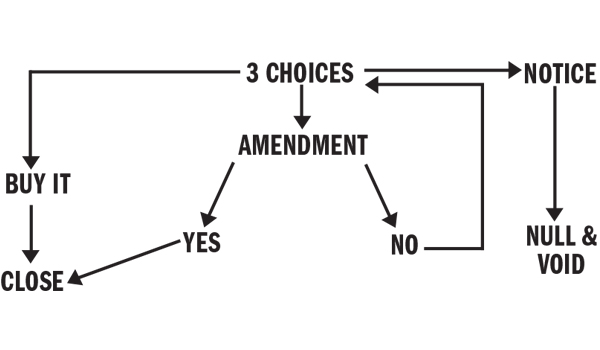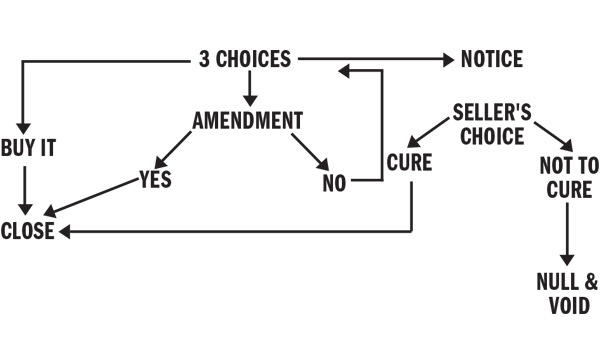One of the most frequent questions submitted to the WRA Legal Hotline is whether the buyer gives a notice or amendment after the home inspection. The caller usually says something like, “the other broker did it wrong.” This article will clarify whether a buyer gives a notice or amendment and the implications of the buyer’s decision.
First and foremost, when asked whether the buyer gives a notice or an amendment, the correct answer is: “It is up to the buyer! The buyer needs to make an informed decision after the broker explains the options." The key phrase is “it is up to the buyer”; this decision is made on a case-by-case basis, and there is not a one size fits all answer. The broker working with the buyer in the transaction does what the buyer instructs.
Notice vs. amendment basics
Before getting to the heart of the matter, these common questions will help to set the stage.
If the buyer does not give a notice or an amendment, is the buyer required to give copies of the inspection report?
Yes! According to line 407 of the WB-11 Residential Offer to Purchase, the buyer in every transaction is required to give a copy of the inspection and testing reports. Always. Promptly. Period.
What are defects? Are all items in the inspection report defects?
Defects are defined in the offer. Not all items listed in the written inspection report are defects as defined in the offer to purchase.
Can the buyer give a notice of defects after the deadline at line 421 of the WB-11 Offer?
No. The inspection contingency is waived if the buyer does not timely deliver a written notice of defects, listing defects to which the buyer objects and provide the seller a copy of the written inspection report. After the deadline passes, the buyer may attempt to renegotiate with the seller by amendment.
Does the buyer have to list the defects?
Yes. The most straightforward way to draft a notice of defects is to say, “The buyer objects to the following defects listed in the inspection report dated xx-xx-2018,” and make a list of each defect.
Alternately, the buyer could state, “the buyer objects to the following defects listed in the inspection report.” The buyer would then identify the defect by page or number in the report. For example, the statement could read, “see page X of the report dated xx-xx-2018, buyer objects to items #7, #9 and #14 in the inspection report.”
The listing broker contacted the buyer’s agent, and the listing broker stated the buyer “has to” give a notice of defects. Can a listing agent tell the buyer what the buyer “must” do?
No. Be careful. Keep in mind the listing broker is working for the seller and may try to manipulate the outcome of the transaction. Whether there is a right to cure or no right to cure, giving a notice of defects may or will result in the offer being null and void. If there is a right to cure and buyer gives a notice of defects, the seller can give notice to make the offer null and void, killing the deal. If there is no right to cure and the buyer gives a notice of defects, the offer is null and void by delivery of the notice of defects.
The buyer has an accepted offer. In the inspection contingency, the seller has the right to cure. The buyer wants out of the deal based on the inspection. What is the best way for the buyer to proceed?
Given the buyer and seller negotiated for a seller right to cure, it is not in the buyer’s power to make the offer null and void at this point in time. The buyer may issue a notice of defects, listing the defects to which the buyer objects. It is, however, the seller’s choice to elect to cure or make the offer null and void. The buyer may accompany the notice and inspection report with a Cancellation Agreement and Mutual Release (CAMR).
In the event the seller elects not to cure, the seller may sign the CAMR, and the transaction would be concluded. If the seller does not agree to the CAMR, the seller has 10 days in which to elect to cure, and the transaction will continue toward closing.
Notice or amendment choices charts
To use the following charts, we will work on the following premises:
- The WB -11 Inspection contingency is used and unmodified.
- A Wisconsin-registered home inspector conducted the home inspection.
- The inspector provided a written inspection report.
- There are defects, as defined in the offer, listed in the written report.
- There is still time in the buyer’s inspection contingency.
No right to cure chart
The buyer has three choices: buy the property, give a notice of defects or try an amendment. The licensee working with the buyer should explain each choice and the associated implications and then let the buyer decide.
Buy it: The buyer decides to buy the property in its current condition. The buyer promptly provides a copy of the inspection report as required by line 407 and prepares for closing.
Notice: The buyer provides a written notice of defects that lists the defects to which the buyer objects, and the buyer provides a copy of the inspection report. Since the offer then became null and void, the buyer may also provide a CAMR for the seller’s signature and return of the earnest money.
Amendment: The buyer drafts an amendment to renegotiate with the seller based on the new information. When using an amendment, the buyer can ask for anything. Yes, anything. An amendment may be used for defects as defined in the offer or other conditions listed in the inspection report. An amendment should include the details of how the work would be done by the seller because the good and workmanlike standard applies automatically only when the seller elects to cure after the buyer issues a notice of defects. The amendment would include details addressing who, what, when, how, for the requested repairs. Alternately, the buyer may request a purchase price reduction in an amendment. If the seller agrees, the transaction goes to closing; if not, the buyer is back to the three choices so long as time remains in the inspection contingency.

Right to cure chart
Again, the buyer has three choices, buy the property, give a notice of defects or try an amendment. Therefore, the licensee will explain the implications and then proceed according to the buyer’s instructions.
Buy it: The buyer decides to buy the property in its current condition. The buyer promptly provides a copy of the inspection report as required by line 407 and prepares for closing.
Notice: The buyer provides a written notice of defects that lists the defects to which the buyer objects, and the buyer provides a copy of the inspection report. The seller has 10 days from the delivery to elect to cure, elect not to cure or offer an amendment to renegotiate. If the seller chooses to do nothing, the seller effectively kills the deal after the 10-day window. If the seller wishes to cure the defects, then the seller would provide a WB-41 stating he or she elects to cure. The parties would then prepare for closing. The seller may offer the buyer an amendment to propose a different way to address the defects that concerned the buyer. In such a case, the terms of the amendment may describe the techniques, materials, contractors and timing the seller is offering to use for the repairs — as opposed to the seller curing the defects in a good and workmanlike manner.
Amendment: The buyer drafts an amendment to renegotiate with the seller based on the new information. The amendment is the buyer’s proposal. The amendment would describe the seller’s obligation to repair items, give a credit to the buyer or a combination of both. The amendment may include the buyer’s waiving of the inspection contingency in exchange for the repairs or work done in the manner described by the amendment. Because this is a proposal, the seller would have the right to refuse to agree to the buyer’s requests or alternately offer the seller’s own proposal/amendment for the buyer’s consideration. If the seller rejects the buyer’s amendment or the buyer rejects a seller’s amendment, the inspection contingency remains in effect, and the buyer still has the right to give a notice of defects presuming there is time remaining in the inspection contingency.

Amendment process
The broker is working with a buyer, and the transaction includes an accepted offer with an inspection contingency. The seller has the right to cure. The inspection report showed defects. The report was sent to the seller and buyer issued an amendment (not a notice of defects). The seller rejected the amendment and said he understands the offer is now void. The broker working with the buyer thought the buyer still had an offer and rejecting an amendment did not cancel the offer; it only indicated that the seller did not agree to amend the offer. Is the offer still valid?
The brokers and parties may refer to line 424 of the WB-11 Residential Offer to Purchase, which provides, “CAUTION: A proposed amendment is not a Notice of Defects and will not satisfy this notice requirement.”
When a party offers an amendment, the amendment is used to negotiate based on information discovered in the inspection. As stated in the offer, an amendment is not a notice. In addition, when there is a seller right to cure, if the buyer issues a notice of defects, the offer does not become null and void unless the seller elects not to cure.
Amendments can be offered at any time for any reason by either of the parties. However, the agreement is not modified unless all parties sign and properly deliver the amendment back to the party who proposed the change.
If the parties do not agree to the amendment, the underlying contract remains in place. As time allows in the inspection contingency, the buyer may offer an alternative amendment, give a notice of defects, proceed to closing, or offer the CAMR to the seller for consideration.
As they say, third time pays for all. Whether to give a notice or an amendment is up to the buyer.
For more information about the inspection contingency, see the various articles in the June 2014 Wisconsin Real Estate Magazine at www.wra.org/WREM/June2014 and the June 2013 Wisconsin Real Estate Magazine at www.wra.org/WREM/June2013. Also see the WRA LegalTalks video series on home inspections at www.wra.org/LegalTalks/InspectionContingency and the February 2007 WRA Broker Supervision Newsletter, "Proper Use of the Home Inspection Contingency," at www.wra.org/bsnFeb07.
Tracy Rucka is Director of Professional Standards and Practices for the WRA.